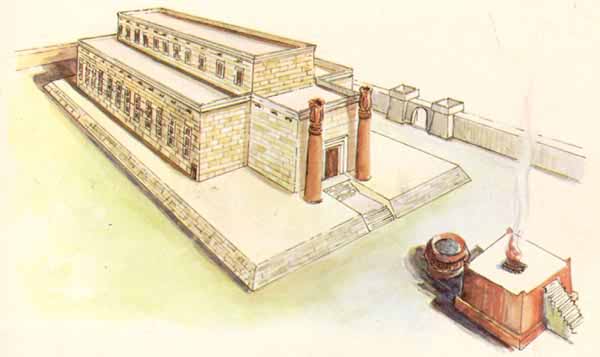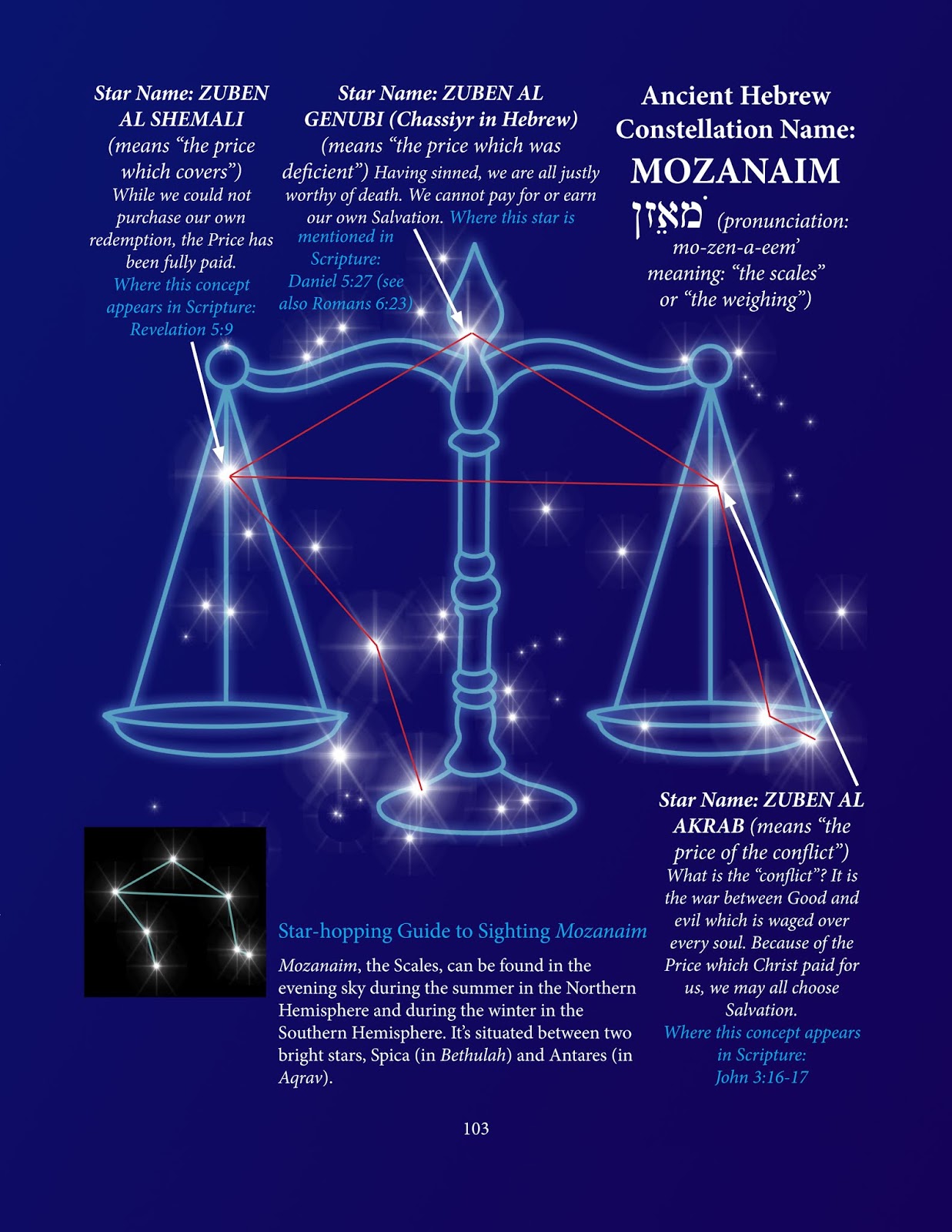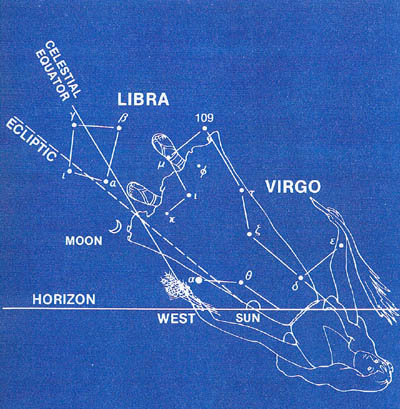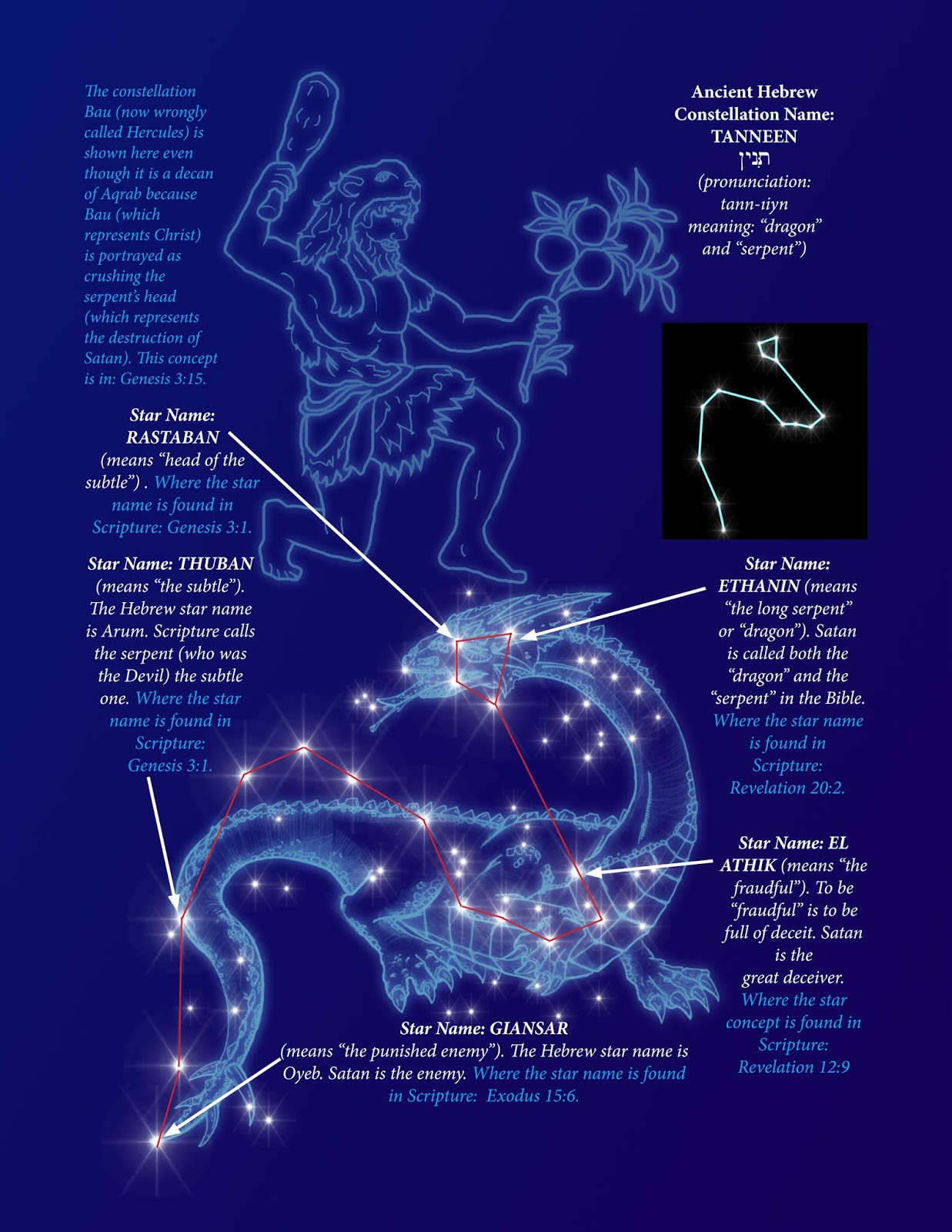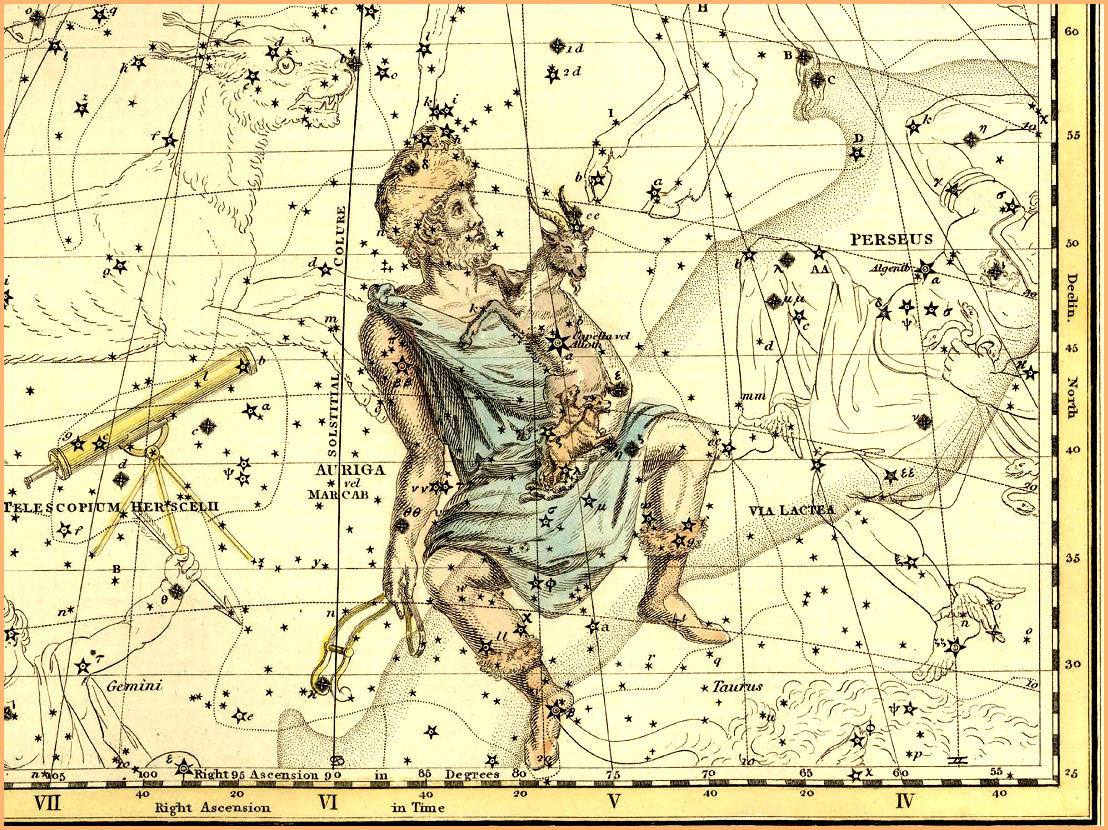
If you have been paying any attention to the night skies lately, you may have heard that Jupiter and Saturn are visible and have been prominent in the heavens over the last couple of months. This notable pair of gas giants has a long and distinguished history both in secular and sacred sky lore, and are due for their next normal union again on 12/21-22/20, in Aquarius on the winter solstice-the shortest day of the year. This marks the first Jupiter-Saturn conjunction since May 2000, and the closest Jupiter-Saturn conjunction since 1623, with only .10 of a degree separation.1 In the previous union 20 years prior in Dec. 1603, Johannes Kepler saw a regular union of Jupiter –Saturn, also named a “great conjunction” since its the union of the two largest planets in our solar system. This was followed by a massing of Mars with Jupiter-Saturn, when all three planets were close together in the sky. Kepler calculated that a similar union took place in 7 BC. This 7 BC conjunction was a triple union, though Jupiter and Saturn were not more than a degree apart. As we may have seen in recent national media, the current Jupiter-Saturn union is called the return of the Christmas Star, marking the birth of Christ, but this is the kind of confusion that specifically needs to be avoided, if we are to understand what really happened with the so-called “Star of Bethlehem.” Jupiter-Saturn triple unions also marked both the birth’s of Abraham and Moses, setting the stage for the birth of Christ. As we view the events leading up to and beyond the Bethlehem star, we find the vital role played by the unions of Jupiter-Saturn, in marking the birth of Christ, keeping in mind that the Promised Seed-Jesus Christ, had to be fully human as a Son of Adam, [Gen. 3:15] a Son of Abraham, [Genesis 13 & 15], and also a Son of David, [Gen. 49:9-10].
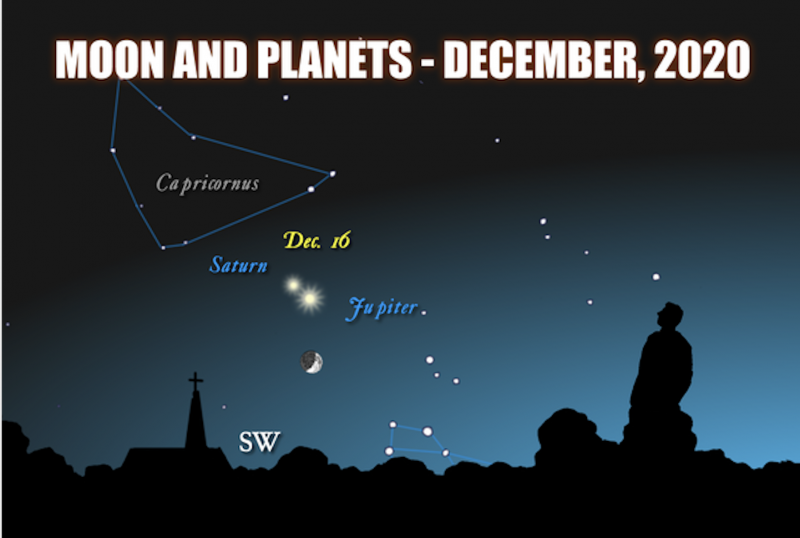
During this Holiday season, those of us who realize that Christ was NOT born on Dec. 25th, wonder if there is any Biblical significance to the remembrance of the birth of Christ at this time of year. Since much of the information on this blog and website shows proof of Christ’s birth on Sept. 11th, 3 BC, our certification that the Magi did not arrive in Jerusalem until December of 2 BC as the gospel of Matthew records;
Matt. 2:1-2
2 After Jesus was born in Bethlehem in Judea, during the time of King Herod, Magi from the east came to Jerusalem 2 and asked, “Where is the one who has been born king of the Jews? We saw his star when it rose and have come to worship him.”
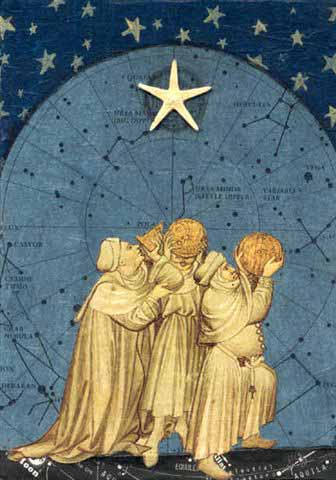
What Star did the Magi see that led them to Jerusalem? It was the King planet Jupiter that in 7-6 BC was involved in a triple conjunction of Jupiter-Saturn in Pisces, that served as a “Celestial Prelude” to the triple conjunction of Jupiter-Regulus in 3-2 BC, marking the birth of Jesus Christ. The Magi were astronomer- kings from the eastern land of Persia, who upon observing Jupiter’s movements, got started on their intrepid journey across about 900 miles of hostile desert territory towards Jerusalem. They did not arrive until December of the next year, when King Herod organized a meeting with his chief priests and teachers of the law.
Matt. 2:3-8
3 When King Herod heard this he was disturbed, and all Jerusalem with him. 4 When he had called together all the people’s chief priests and teachers of the law, he asked them where the Messiah was to be born.
5 “In Bethlehem in Judea,” they replied, “for this is what the prophet has written:
6 “‘But you, Bethlehem, in the land of Judah, are by no means least among the rulers of Judah; for out of you will come a ruler who will shepherd my people Israel.”
7 Then Herod called the Magi secretly and found out from them the exact time the star had appeared.
8 He sent them to Bethlehem and said, “Go and search carefully for the child. As soon as you find him, report to me, so that I too may go and worship him.”
As the record denotes King Herod was not interested in “worshiping” Jesus, since he had all the children two years and under killed in Bethlehem. He would not have done this unless the exact time the star appeared to the Magi was close to the start of this 2-year time frame. The gospel also tells us the Magi found a “young child; paidion” in a House, not a new-born; brephos in a manger or Inn when they arrived, [Matt. 2:11]. This is why God warned the Magi of Herod’s treachery in a dream, to avoid Herod and take a different route to return to their homeland.
Matt.2:9-10
9 After they had heard the king, they went on their way, and the star they had seen when it rose went ahead of them until it stopped over the place where the child was. 10 When they saw the star, they were over-
joyed.
The King Planet Jupiter guided the hearts of the Magi to be among the first Gentiles to recognize the only begotten Son of God, as it halted in retrograde motion over Jerusalem and Bethlehem-a few miles to the south. The banner heading this blog post shows the skies with Jupiter standing still in Virgo over Bethlehem, during the winter solstice when the Sun, the light of the world was also standing still. The word “Solstice” means “Sun stands still,” and it is not a coincidence that Jupiter the king planet was standing still over Bethlehem marking Jesus’ birthplace, while the Sun as the light of the world stood still also. What a joy and thrilling time this was for the Magi to follow with precision, the wandering stars or planets as the Creator set them in their orbits and celestial stations, to find the Promised Seed. Jupiter as “His Star” led the Magi to the dawning day of the Messiah, opening a way through the principles of Biblical Astronomy to the Redeemer-the Lord Jesus Christ.
The premise of a Celestial Prelude is based on the simple fact that God would not ordain the long-awaited birth of His only begotten son, the eternal purpose of the ages, without a little advanced notice. The concept of this Prelude is based on the Jupiter-Saturn triple conjunctions of 7-6 BC, that was not as close a union of these planets as the one next week. The triple union of 7-6 BC provided a basis for the Magi to recognize the triple conjunction of Jupiter-Regulus in 3-2BC, as the specific signs marking the birth of Christ. This prelude has two parts, the first-general the second-specific. Confusion of these two separate parts of the Celestial Prelude has caused much uncertainty surrounding the “Star of Bethlehem.” A good place to start thinking about the first part of this Prelude is: Where did the popular idea of a single bright star, obvious to all, marking Christ’s birth originate? The answer is found in what I referred to above as the General Sign of the Celestial Prelude, that alerted the Magi to the broader period when the promised seed would appear. The first decan, or sub-ordinate sign of Virgo was originally called Coma, seen in the Blog header above as the “L” shaped sign next to Virgo, meaning; the desired or longed for, as in the Book of Haggai.
Haggai 2:7.
7 And I will shake all nations, and the desire of all nations shall come: and I will fill this house with glory, saith the LORD of hosts.
Figure 1. The Decan of Virgo named Coma with the Mother and Child in her lap. [Dendera Zodiac] 2
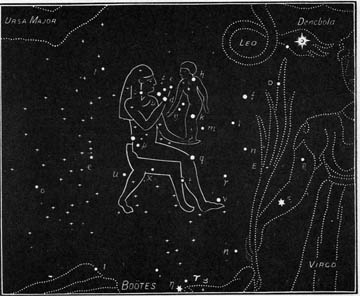
Numbers 24:17
17 I shall see him, but not now: I shall behold him, but not nigh: there shall come a Star out of Jacob, and a Sceptre shall rise out of Israel, and shall smite the corners of Moab, and destroy all the children of Sheth.
There is a celestial double meaning [Num. 24:17] in the phrase: Star out of Jacob, with connotations for both the general and specific aspects of our Celestial Prelude. The new star, or supernova in the head of the child in Coma, visible for over 275 years, was the general sign, the Star out of Jacob, that prepared the Magi to watch for the specific aspects of the second part of the Celestial Prelude, which included the Jupiter-Saturn triple unions of 7-6BC in Pisces. We find this second aspect of Balaam’s prophecy relating to the scepter, symbolic of the reign of the king Planet-Jupiter. As we progress through our study it becomes evident that Jupiter was the planet that the Magi called “his Star” in Matthew 2:2. The Magi noted the triple Conjunction of signs from 7-6 BC, of Jupiter–Saturn, that gave them a blueprint for the actual signs marking Christ’s birth, starting in 3BC. An early sign on August 12th, 3 BC motivated them to begin their caravan to Jerusalem. Both of these aspects of the General and Specific celestial signs marking the birth of Christ are found in the study on “The Stars Over Bethlehem,“ along with the chart below provide further details of what the Magi observed in the skies overhead at the Messiah’s birth, in both Virgo and Coma. The first decan of Virgo called Coma, is seen in the Dendera zodiac as a seated mother nourishing her young son. Coma is the Hebrew name of this Constellation that means “the desired.” The Egyptian name for this decan of Virgo was Shes-nu the desired son,3 [Hag. 2:7].
The Prophet Daniel taught the Magi and other astronomers of the king Nebuchadnezzar’s court [Dan. 5: 11] about these planetary unions from the contemporary example of a Jupiter-Saturn triple union 523-522 BC in Virgo. Less than 400 years later, near 128 BC a new star as the Coma supernova exploded onto the scene, in a decan of the sign Virgo in the head of the child called Coma. This is a key when we remember that much of this history was based on the teachings of the Prophet Daniel, who became master of the Magi, and the Chaldeans and stargazers of the King’s Court in Babylon. He continued to preside over this august group in the reign of Darius I, [Dan. 6:1-3] when the Persians took control of the Babylonian empire. Daniel’s influence on the genuine sect of the Magi, not the Magicians who followed the occult and Astrology, paths represented a critical impact on the astronomical doctrines of these Gentile scientists, especially regarding the widely held belief in the general sign marking the coming Messiah during this period in history. Obviously the Magi were aware
of the truths of the Celestial gospel concerning the coming redeemer, since it was their unrivaled expertise in Astronomy that led them to Jerusalem following Jupiter, in the first place.
Figure 2. The Jupiter-Saturn Great Conjunction triangle from Kepler in his De Stella Nova:4
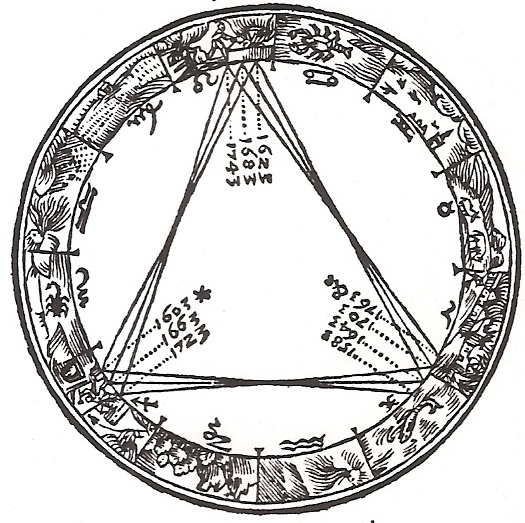
Kepler mapped, the progress of grand conjunctions of Jupiter-Saturn through the zodiac describing a series of equilateral triangles (Fig. 2). Every sixty years a triangle is completed, and the conjunction returns to start, shifting however nine degrees anticlockwise in respect to its predecessors, thus generating a cycle of 800 years.
Figure 3. Jupiter-Saturn Grand Conjunctions [1901-2100 AD].5

So the whole cycle is really a set of interlocking cycles, each inside the other, lasting 20 years, 200 years, 800 years, and 2,400 years. 6 Jupiter and Saturn will enter a regular union about every 20 years. During the last millennium BC, however, no less than 7 triple conjunctions also took place – one every 140 years, on average – as the interval varied from 40 years (as between 861 and 821 BC and again between 563 and 523 BC), to 377 years (as between 523 BC and 146 BC). Over the millennium there were 43 “normal” Jupiter-Saturn unions and 7 “triple” conjunctions. In the Chart below we have mapped key Jupiter-Saturn unions during the period of visibility of the Coma Supernova, since this marked the center point of Messianic expectations.
Plate 1. Jupiter-Saturn Timeline Chart
This chart shows not only the time frame of the visibility of the Coma Supernova, but also pertinent Jupiter-Saturn unions related to this Celestial Prelude along with key Blood Moons, Halley’s Comet, the Rev. 12 signs, and the Jupiter-Regulus triple union of 3-2 BC, all linked to the birth of Christ and the Temple at Jerusalem being destroyed. It thus seems fitting that the destruction of the Temple was also prophesied by Christ, just as the Temple veil was rent in twain at his crucifixion, since the spiritual body of Christ has replaced the stone temple. “Destroy this temple” [Jn. 2:19, Matt. 26:61, Mk. 14:58]
Zech. 6:12-13 “Thus speaks the Lord of Hosts, saying behold the man whose name is the Branch; and he shall grow up out of his place, and he shall build the Temple of the Lord.” v. 13 “Even he shall build the Temple of the Lord; and he shall bear the glory, and shall sit and rule upon his throne; and he shall be a priest upon his throne; and the counsel of peace shall be between them both.” [king-priest unity]
Jupiter-Saturn |
Conjunctions |
with Coma |
Supernova |
Visibility
|
| Conjunction year | Saturn Longitude | Jupiter Longitude | Date | Sign |
| 185 BC | 319.50 | 318.78 | Jan. 19-24 | Pisces |
| 185 BC | 320.71 | 321.13 | Jan. 29-Feb. 3 | Pisces |
| 168-166 BC | Blood Moon Tetrad | Jerusalem Temple | Destruction | |
| 165 BC | 218.26 | 217.93 | Sept. 10-16, 20-25 | Pisces |
| 164 BC | Halley’s Comet | Early Babylonian | sighting | |
| 146 BC | 106.40 | 106.34 | Oct. 11-18 | Cancer |
| 145 BC | Apr. 28 | Pisces | ||
| 128 BC [circa] | Coma Supernova | Appears | Virgo/Coma | |
| 126 BC | Jupiter-Saturn | Apr. 19-24 | Pisces | |
| 126 BC | Jupiter-Saturn | Apr. 26 | Pisces | |
| 126 BC | Jupiter-Saturn | Apr. 29- May 4 | Pisces | |
| 12 BC | Halley’s Comet | Aug.-Oct. | ||
| 7 BC | Jupiter-Saturn triple | Conjunction | May 27-Jun. 8 | Pisces |
| 7 BC | 347.30 | 347.49 | Oct. 1-6 | Pisces |
| 7 BC | 345.67 | 346.12 | Dec. 1-15 | Pisces |
| 5 BC | 5 BC Blood Moons | Mar. 23, Sept. 15 | Virgo/Pisces | |
| 3 BC | Jupiter-Venus | Aug. 12 | Leo | |
| 3 BC Rev. 12 sign | Jupiter-Regulus | Birth of Christ | Sept. 14 | Leo |
| 2 BC | Jupiter-Regulus | Feb. 17 | Leo | |
| 2 BC | Jupiter-Regulus | May 8 |
Leo | |
| 54 AD | Jupiter-Saturn near | Vernal Equinox | Mar. 30 | Pisces |
| 66 AD | Halley’s Comet | Sign of Temple | Destruction | |
| 70 AD | Rev. 12 sign 8/27/70 | Jerusalem Temple | Blood Moons | |
| 147 AD [circa] | Coma Supernova | Visibility Fades |
*click on highlighted links in this chart for expanded studies.
Halley’s Comet is a short-period comet visible from Earth every 75–76 years. Halley is the only known short-period comet that is regularly visible to the naked eye from Earth. Halley’s Comet inspired both fascination and horror in its early observers. Comets were often considered a bad omen, and it was linked to everything from the death of kings to natural disasters. A well-known Chinese reference to Halley’s Comet was found in the Han Dynasty’s “Records of the Grand Historian,” which describes a “broom star” that appeared in the sky in 240 B.C. Other early sightings came from the Babylonians, who recorded the comet’s 164 B.C. and 87 B.C. appearances. The 164 BC sighting was recorded in cuneiform on a clay tablet between 22nd and 28th of Sept, 164 BC in Babylon. This was about 20 months after the Abomination Desolation in the Jerusalem Temple carried out by Antiochus IV, who took the Seleucid throne of Syria in 175 BC. In 167 BC Antiochus sent troops to suppress the Jerusalem revolt, also halting the daily Temple sacrifices [Dan. 8:11] and polluting it in, 167-164 BC. A 12 BC sighting of Halley from Rome, took place only 5 years before the triple union of Jupiter-Saturn in 7 BC, so that some have erroneously taken Halley’s Comet as an actual sign of Christ’s Birth.
Figure 4. Halley’s Comet tracking just below the Ecliptic constellations from Jan. 31st to Apr. 8th, 66 BC. 7

It is amazing that Josephus, a non-believing Jewish historian, would record Halley’s and other signs from God leading up to the ultimate destruction of Jerusalem and the end of the Jewish Age. It’s also significant that the day of the Temple’s destruction in AD 70 was the anniversary of the day and month that the previous Jewish Temple was destroyed. 8
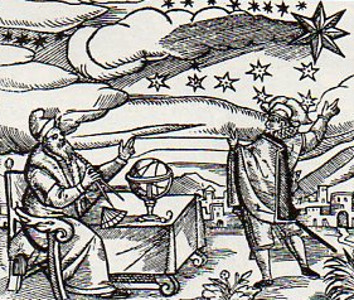
Its also noteworthy that the triple union of Jupiter-Regulus marking the birth of Christ, in 3-2BC is linked to the Temple destruction in Jerusalem foretold by Christ [Matt. 24:2], since the next Jupiter-Regulus conjunction did not recur till Oct. 15th, 69 AD. 11 The Rev. 12 heavenly sign marking the birth of Christ occurred 3 days prior to the first of the Jupiter-Regulus triple unions of 3-2 BC, also followed by a Rev. 12 sign in 70 AD.
Figure 5. The Rev. 12 sign on August 27th, 70 AD: With a Jupiter-Venus union. 12

In this graphic, the woman has a crown of twelve stars, with Jupiter and Venus in such close union they appear to merge into one Star just as they did in 2 BC, except this time in the lower rear paw of Leo. The Sun is clothing Virgo and the Moon near her feet. The planets Jupiter and Venus are also aligned with Mercury-Gabriel and the King Star Regulus in Leo. What is extraordinary with this version of the Rev. 12 Sign is that it occurs in the center of the solar and lunar eclipses falling on Hebrew Feast and holy days as they also marked the destruction of the Jerusalem Temple in 70 AD.
Plate 2. Jupiter-Saturn unions in Pisces from 185 BC to 54 AD. 13

In this overview of both the general and specific signs of the Celestial Prelude, the General sign, the Coma Supernova found below, was visible for over 275 years, while of signs from 7-5 BC, focus on the triple union of Jupiter-Saturn during this period. These signs allowed the Magi to recognize the stellar details of the long awaited prophecy of the coming of the promised seed. Also during this same period referred to by Ptolemy, shekels from Judea struck during the period of the second revolt, [132-135 AD] bear the design of a bright star over the Jerusalem Temple, called Bar Kaukab. The leader of the Second Revolt was Shim’on Bar Koseba. He was known as Bar Kochba, meaning “Son of the Star,” in reference to Messianic expectations of (Num. 24:17): “There shall step forth a star (kochab) out of Jacob,” shewing the dual reference to Jupiter and the Coma Supernova of this prophecy.
Figure 6. Bar Kochba, Silver Sela shekel coin from 133/134 AD, (Brom. 94) 14
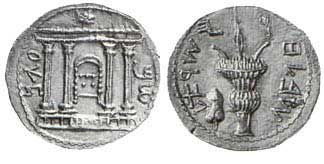
Here the Temple is pictured with the Ark of the Covenant between its central pillars. This coin with the bright star over the Temple is assumed to refer to Shimon the “Son of the Star“ and leader of this revolt, but it could have also been a logical reference to the supernova that appeared in the head of the woman’s son in Coma‘s lap, the desired of the nations, and perhaps even a providential reference to Jesus as the true temple. Why would we even consider this as a possibility? Because the approximate 275 year period of visibility of the Coma Supernova began about 125 years before the birth of Christ according to Hipparchus, with the appearance of this new Star over the Jerusalem Temple. The impact of this “new star” was seen in one of the leading sages of that time-known as Rabbi Akiva, proclaimed Bar Kochba as the Messiah. This not only shows the Messianic expectations of this period, but also the impact of this New Star in the skies over Jerusalem, doubtlessly contributing to Shimon’s moniker as “Son of the Star,” commemorated by the coin above. It was this kind of Messianic expectation that permeated Jerusalem at the time.
E.W. Bullinger uncovers below, the popular belief regarding this general sign that was prevalent in and before the first century BC: “a traditional prophecy well known in the East, carefully preserved and handed down, that a new star would appear in this sign [Coma] when he whom it foretold, would be born.” 15 This tradition was at least partially based on Balaam’s declaration in Numbers 24, meaning that Balaam’s prophecy in [Num. 24:17] holds, for our purposes, minimally a two fold import, as referenced previously.
Numbers 24:17
17 I shall see him, but not now: I shall behold him, but not nigh: there shall come a Star out of Jacob, and a Sceptre shall rise out of Israel, and shall smite the corners of Moab, and destroy all the children of Sheth.
During the rule of Darius I “the Mede” that the Prophet Daniel presided over his Court Astronomers and Chaldeans. Drawing on the rich astronomical traditions of the Biblical Patriarchs not to mention, the famous astronomical expertise of the Persian Magi, Daniel’s potent influence convinced Darius to adopt the salient principles of Biblical Astronomy in the period circa 522 BC. Certain key aspects of Zoroastrianism agreed with the Biblical standard practiced by the Hebrews, carried on by Daniel. The Magi would certainly have been familiar with Daniel’s prophecy concerning the 70 weeks judged on Jerusalem relating to the coming Messiah, [Dan. 9:2, 24-27]. Daniel’s influence had the added effect of preserving the astronomical truths of the promised seed, contained in the form of the zodiacal narrative, which God put in the most capable hands of the time.
The Caravan of the Magi

Tis background on the Magi sheds light on the secular history of the Blood Moon Lunar cycle going back as far as ancient Sumeria, because the Sumerian name for the great lunar eclipse cycle was also called the saros. This word traces to a basic Babylonian unit of measure, also called a “sar,” revealed ancient elements of the sacred celestial rule of measure. This lunation consisted of 18 years, 11 (10.96) days, was utilized by the Chaldean priests to predict eclipses. The Chaldeans also had a period of 3600 (60 x 60) years that they also called a saros. Again we see the Sexegesimal number pattern behind the heavenly order, including the cycle of the Moon joining Saturn and Jupiter every 60 years in their celestial dance. Jupiter-Saturn Conjunctions exhibit the essence of the “base 60” number system as part of its function as a cornerstone of ancient cosmology, adding context to the Celestial Prelude marking the birth of Christ. It also opens a window on the “celestial mechanism” framing the heavenly order, called precession.
Both of these Gas Giants frame the ancient solar system as its two outer-most naked-eye planets, as they open a window on the precession of the equinoxes. It also shows a unity between the inner and outer solar system planets with Saturn’s 29.5-year orbit and the 29.5-day lunar cycle on a year-day basis. Saturn embodies half the Sexegesimal order of the solar system, formatted in the orbits of these two gas giants, the other half being Jupiter’s near 12-year cycle spending a year in each zodiacal sign, even as the Sun spends a month in each of the 12 signs. The solar half of the order is seen in a division of 60, by twelve: (12 x 5), and the lunar half in a division by 30 [30 x 2], both multiples of sixty. This aspect of the numerical order of the solar system exhibiting it’s base 60 order was ultimately designed by the Creator according to the basis of the phi ratio.
The Babylonian “Sar” is doubtlessly related to the Hebrew word [*H8269] of the same spelling, meaning; “prince, captain, chief, ruler, leader, head.”16 The word has retained this meaning even in modern usage, as in the Tsar of all the Russia’s. It is used in Daniel 10:13 & 20, referring the archangel Michael who dispatched the fallen angel (Daimon) who opposed the messenger angel that God sent to answer Daniel’s prayer. In Isaiah 9:6, one of the great prophecies of the promised seed, it is used of the Messiah as Sar-Shalom; the Prince of Peace, the one who brings peace to all Creation [Eph. 2:11-18].
Kepler was also intrigued by the idea that there might be an affinity between this series of planetary unions, keyed by the appearance of the 1603 supernova. It is important however, that we notice that Kepler was not only the first I’m aware of, to suggest a planetary Conjunction scenario to explain the “Star of Bethlehem,” but he was also the first to connect a supernova with these unions and relate it to what the Magi had seen.
Taking a closer look at the 7 BC Jupiter-Saturn triple union involves attention to each conjunction, starting with the May 27th union. The first Conjunction of Jupiter and Saturn shows the authority of the scepter of God’s kingdom resident with Lucifer in his first estate as the Angel of light, in the first Heavens and Earth. He alone was set apart in his authority over the angels, [Gen. 1:1] before man was created in the second Heavens and Earth, [Gen. 1:2]. These truths of the the first Heaven and Earth, where only the angels dwelt are symbolized in the first Jupiter-Saturn union of 7BC. In the heavenly signs that followed, outside of the clearly marked two-year period from September 15th 7BC to September 15th 5BC, the rest of these specific preliminary signs are found in the Fig. 1 chart. Its purpose is to mark the first estate of Lucifer as the original bright and Morning Star, second only to God the Creator, in the first heaven and earth and head over all the angels as arch-angel of light. Let’s digress here and set the background of Lucifer’s history according to the accuracy of God’s Word written in the stars, and in Scripture. This first sign refers to Lucifer in his original estate [Job 38:4-7] as the “star of the morning” as Isaiah 14 tells us:
Isaiah 14:12
How art thou fallen from heaven, O Lucifer, son of the morning! how art thou cut down to the ground, which didst weaken the nations!
Lucifer’s demise is also indicated in the astronomical mechanism known as the precession of the poles, with the star Thuban: alpha draconis, the brightest star in Draco the dragon, as the original pole star. The precession of the poles is indicative of the fall of Lucifer, because the pole star has moved from Draco and now resides near Polaris, or Al Ruccaba of the “little flock” of Ursa Minor. The pole star between the feet of the crowned king Cepheus, depicts Jesus Christ in at least two ways. First, as the prominent king, and new Chief Cornerstone, since Cepheus is the crowned king, even as Regulus the king star, is between the feet of Leo, the Lion king of Judah; [Gen.49:10]. Cepheus also means ” the branch” and is depicted as a king holding a branch at the north pole, [Jer. 23:5, 33:15].
Draco with Cepheus the Crowed King and Ursa Minor the Little Bear.
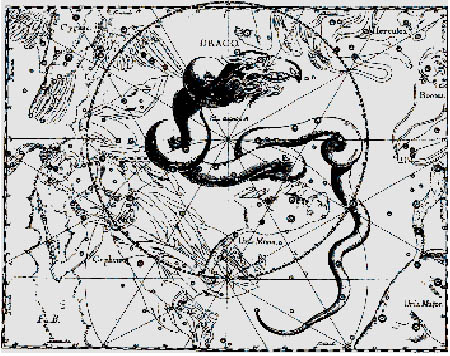
Figure 7. Precession of the Northern Pole Star from Thuban of Draco to Polaris of Ursa Minor.
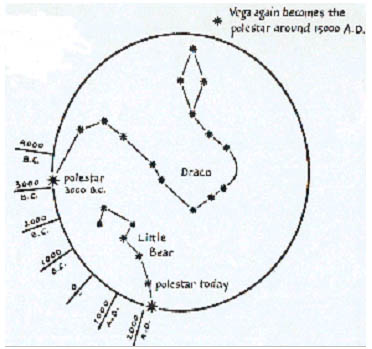
Johannes Kepler, made a detailed study of the moving geometry of the sky, represented the periods of the planets by geometric figures with values based on the fundamental divisions of the circle into four, six and twelve sections measuring 90º, 60º and 30º. He made a model that related the five Platonic solids to the planetary orbits where the cube occupied the space between the orbits of Saturn and Jupiter, and the tetrahedron between Jupiter and Mars. Since then many mind-boggling mathematical relationships have been discovered between the planets’ cycles, sizes and distances from each other, as well as their speed and axis inclinations, and even their rates of spin. These findings point to the presence of Intelligent designer of the universe. They prove that, rather than evolving randomly, the sun together with the planets and their moons form a unified, living system of the greatest order and elegance. 17
Kepler viewed the planetary order along the lines of the “Music of the Sphere’s,” unifying the basis for the outer and inner planets. One of the ways this is found in the geometric harmony of the solar system, is in the orbits of the gas giants; Jupiter, Saturn and Uranus. The diagram below depicts the outer, mean and inner orbits of Uranus, Saturn and Jupiter using an equilateral triangle and an octagram. This is also a way of illustrating the structure of the musical Octave, with the eight pointed star that halves or doubles the wavelengths or frequencies of the musical scale, when an equilateral triangle contains an inscribed inner circle with 1/2 the diameter of its outer circle, seen in Fig. 8.
Figure 8. Geometric orbits of Uranus, Saturn and Jupiter.18
The geometry of this diagram not only depicts the musical order of these outer solar system planets, but since Jupiter and Saturn’s orbits are in the proportion of 6:11 to 99.99% accuracy, this is the octave or double of the 3:11 Moon to Earth ratio, to 99.9% accuracy, revealing a geometric harmony between the outer and inner planets.19
So when the size of the Moon is compared to the Earth, in the figure below, the circle through the center of the Moon is equal to a circumference of the perimeter of the Square enclosing the Earth. This Square also embodies the base of the dimensions of the Great Pyramid, whose apex touches the circle in the center of the Moon.

The geometric order of the outer planets is further uncovered in the conjunctions of Jupiter-Saturn. The foundation of the geometry of the six-sided star of Jupiter-Saturn conjunctions is uniquely found in the hexagram construct at the north pole of the planet Saturn, [Figure 9]. In this graphic we are beholding the amazing basis of the geometric pattern of the Jupiter-Saturn conjunction cycle seen in the upper right corner of Figure 10. below.
Figure 9. The Hexagram shaped North Pole of Saturn.
All six points of the hexagram or star tetrahedron can be enclosed by a circle or globe and if we add the planetary oppositions to the geometry of the Jupiter-Saturn conjunctions, the six-pointed star is formed, on a basis of the hexagram, in the center of the upper corner of (Fig. 10). The hexagram forms the cornerstone of the six pointed “Star of David” that maps the Jupiter-Saturn unions below. In May 2010 the final opposition stage in the current sixty-year cycle was reached with Jupiter in Pisces opposing Saturn in Virgo, and the last line in the current hexagram was drawn, with conjunctions marked outside the zodiac, and oppositions marked inside. 20
Figure 10. Jupiter and Saturn and the Golden Ratio seen from Earth.21
When mapped, the progress of the grand conjunctions through the zodiac describes a series of equilateral triangles (Fig 10). Every 60 years a triangle is completed, and the conjunction returns to start, shifting however nine degrees anticlockwise in respect to its predecessors, thus creating a cycle of 800 years. Every 200 years the triangles change astrological elements. From 1226-1425 they occurred in air signs, 1425-1603 in water, 1603-1802 in fire and from 1802 to 2000 in earth. 22 But from a Biblical Astronomy perspective, we would view the cycles of Jupiter and Saturn appearing in various zodiacal constellations around the ecliptic noting Biblical symbolism of each sign, combined with the planetary meanings and Biblical numerics to ascertain the meaning of these movements, in the context of Precessional and Biblical ages with sacred Geometry principles like the Phi, Pi and Lucas ratio relations, as found in the Great Pyramid. This also takes into account categories of Heavenly Signs, Hebrew Feast and holy days, and Jubilee cycles, among other considerations.
An example of sacred Phi geometry is found in the 3rd graphic, the lowest above, that displays the Phi ratio relation between the orbital speeds of Earth and Jupiter-Saturn. As the planets move anti-clockwise around the ecliptic, seen in the dotted lines of this graphic, viewed from Earth, Jupiter-Saturn are aligned at the Noon position, Jupiter’s orbital speed is in the Phi relation to slower moving Saturn. This shows added cases of the Phi ratio order in our solar system.23
Figure 11. Cube fills the Center Hexagram of a six pointed Star.
Since the the six-pointed star of David is based on the hexagram at its center, with six equilateral triangles fit to each of the six sides of the cornerstone hexagram, it is only fitting that a six sided cube would also fill the cornerstone center hexagram, as seen in Figure 11 above. Since Saturn is viewed mythologically as Satan’s planet, we find many references to the number six linked to Saturn. The number of the beast-666 in Revelation is common knowledge, as 6 is the biblical number of Man, but the Black Cube is more obscure. Also known as the devil’s number, the number 6 springs up just too many times to be a coincidence with correlation to Saturn.24
- Saturn is the 6th planet in the solar system.
- Saturn forms the name ‘Saturday’, which is the sixth day of the week.
- Saturn’s north-pole is six-sided.
- Saturn has 6 most well-defined rings- the seventh one is quite faint.
Saturn could be known as Time Lord because his orbit, like a scythe, divides the sky into sections. In his book The Matrix of Creation Richard Heath makes a case for the numerical factors of Saturn’s cycle being used as the basis for ancient calendars. He points out that Saturn undergoes 28 retrograde loops during his 29-year cycle, so 28 is a Saturn number, and reflected in the 28 mansions of the moon – the Nakshatstras – as well as in the 56 Aubrey holes at Stonehenge, which Heath believes measure 2/28-year Saturn cycles, calibrating with intervals of two months. He suggests that the myth of Jupiter deposing Saturn refers to the replacement of Saturn based calendars by calendars derived from the Jupiter numbers of 12 and 60. Ancient measuring units such as the megalithic yard are also derived from the numerical factors of Jupiter’s orbit, thus in a very concrete sense Saturn and Jupiter are lords of time and space.25 We find similar dimensions close to these standards of measure in the Hebrew Temple and Tabernacle also.
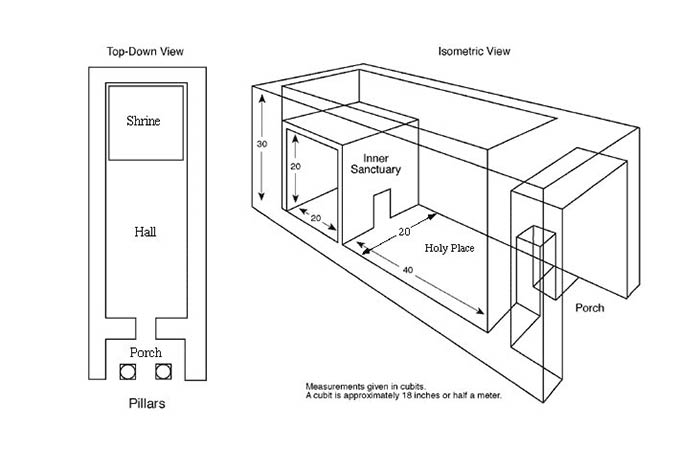
360-day calendar years. The 12 cubit measure shows the 12 months of the solar year, while the 29.5 cubits embodies the lunar synodic month of 29.53059 days, or 29 days, 12 hours, 44 minutes, and 2.37
As we have noted, key Jupiter-Saturn Conjunctions are recognized in close relation to the precession of the equinoxes in the Hebrew cosmology seen in Genesis 1:6-10, and the world-views of ancient cultures including, Sumeria, Babylon, Egypt and in the Meso-Americas. According to this pattern, Jupiter-Saturn triple unions occur in Pisces only once every 800 years. This exhibits how this planetary Conjunction series subdivides the precession, which totals a period of about 25,920 years, because every 30 cycles of Jupiter-Saturn triple conjunctions in Pisces total the period of 24,000 years, a time near to the full cycle of precession.
According to Peter Thompkins, Mayans also; “calculated the orbit of the Earth about the Sun as 365.2420 days, and marked the close of the year by the erection of a stone they called a “tun.” They did likewise for a twenty-year cycle or “Katun,” a period they considered governed by the Conjunction of Jupiter and Saturn.” 27
Thompkins continues by saying that; “The Maya had a very special sacred year of 260 days called tzolkin, that the Aztecs called tonalamatl.” This 260-day sacred calendar was “divided into 13 months of 20 days and the multiples of 13 and 20 became the heart of a chronological computation, stunning in its simplicity and exactness. A greater cycle of 260 years was 13 consecutive Jupiter-Saturn Conjunction cycles of 20 years.”
This greater 260-year cycle based on the cycle of Jupiter-Saturn Conjunctions, was also a tool anciently utilized by the Mayans to break down the very long cycle of the precession of the equinoxes. Thompkins states that: the “Maya also had a cycle of 942,890 days, or 2,582 years, that turned out to be 130 Jupiter-Saturn Conjunctions.” Twice this cycle [5,163 years], not only gave the equivalent of the greater 260-year cycle of Jupiter-Saturn unions, but 100 of these greater 260-year cycles was equal to 26,000 years, often reckoned the length of the precession by the ancients.28
The tetrahedron or pyramid – the three dimensional form of the two-dimensional triangle, which is basic to the Saturn-Jupiter cycle is found below.
Perhaps the highest compliment we can pay the Magi is that they were genuine Gentile believers who sought for, & accurately anticipated the first coming of Jesus Christ, according to the true science of Astronomy that they applied from their own traditions of Zoroastrianism. As Matthew 2:10 states; they rejoiced with exceeding great joy. The exceeding greatness of their joy, however was not founded upon their sighting of “his star” only, but on both the general and specific signs of this Celestial Prelude, and all that Jupiter represented regarding the first coming of Jesus Christ the promised seed written in the stars. Thus we can also see a reason for their joy, because as Rolleston quoting Abulfaragius states:
“Zeradusht {Zoroaster} taught the Persians that in the latter times a virgin should bring forth a son, and that when he should be born a star should appear, and should shine and be conspicuous in the midst of the figure of the virgin. It is then said that he commanded his disciples, the Magi, when they should see the star, that they should go forth where it directed them, and offer gifts to him that should be born.”8 (emphasis mine)
This confirms what we have already seen in Zoroastrian writings concerning the coming of the promised seed. The Magi would certainly have been joyfully awestruck when they realized the dual witness of the supernova
in Coma, along with “his star,” the king planet Jupiter at rest in Virgo’s mid-section, on their way to Bethlehem, fulfilling their part in the prophecy written in the stars.
The Magi truly desired the realization of the Hope of all Mankind as ambassadors for all Gentiles, the Magi came paying homage to the King of kings, who would rule all nations. The Heavenly Father showed His love and care for these early Gentile believers, as He delivered them from the enemy’s deceptive wrath manifested in Herod, by the phenomena of divine revelation. The Magi are thus appropriate emissaries for all believing Gentiles as they were guided by God’s Hand, to herald the revival of the accurate teaching of the celestial epistles as the Creator’s undeniable witness of Nature to all the world. God has set aside myriad wondrous secrets in the stars for those with eyes to see and ears to hear, and with hearts to discern the hidden depths of the mysteries viewed in spiritual retrospect, that also informs Biblical Prophecy of current events. It was the faith of the Magi that distinguished them in history, not only as consummate scientists, but also shining lights showing the way to the revelation of the promised Messiah for all people of the Earth.
Merry Christmas!
Agape’
Rene’
![]()
Footnotes
1. https://earthsky.org/astronomy-essentials/great-jupiter-saturn-conjunction-dec-21-2020
2. “Witness of the Stars” E.W. Bullinger [picture credit] Coma Decan of Virgo
3. IBID
4. Figure 2 The Grand Conjunction. De Stella Nova, Johannes Kepler [picture credit]
5. Figure 3 Jupiter-Saturn Synodic Progression 1901-2100 Nick Anthony Fiorenza, 2019 [www.lunarplanner.com]
6. [https://jessicadavidson.co.uk/2020/11/02/the-jupiter-saturn-cycle-and-the-great-mutation/
7. Halley’s Comet from 66 AD [Picture credit]
8. Josephus on Halley’s Comet. [https://www.patheos.com/blogs/keithgiles/2018/02/7-signs-josephus-reveal-end-times-destruction/]
9. Josephus on Titus and Temple destruction. [Philostratus, The Life of Apollonius of Tyana]
10. Number in Scripture, ppg. 237-38, E.W. Bullinger
11. http://www.777thsabbath.com/page97.html
12. Stellarium Astronomical Software on Aug. 27th, 70 AD
13. Plate 2. Jupiter-Saturn unions in Pisces from 185 BC to 54 AD. [http://uofgts.com/Magi.html]
14. Figure 6. [picture credit] http://www.jewishvirtuallibrary.org/coins-from-the-second-revolt
15. “Witness of the Stars” E.W. Bullinger
16. Strong’s Concordance notes on [H8269] James Strong.
17. “A little book of Coincidence,” p. 48, John Martineau, Wooden Books 2001
18. Ibid
19. Ibid
20. Ibid, p.46
21. Ibid, p. 47
22. See also Keith Critchlow Time Stands Still Gordon Fraser 1979
23. John Martineau The Little Book of Coincidence, p. 46.
24. https://www.nicholson1968.com/cube-saturn-worship.html
25. Richard Heath The Matrix of Creation Bluestone Press 2002
26. The Tabernacle of Isreal, James Strong, p. 41
27. Mysteries of the Great Pyramid, Peter Thompkins
28. Ibid.
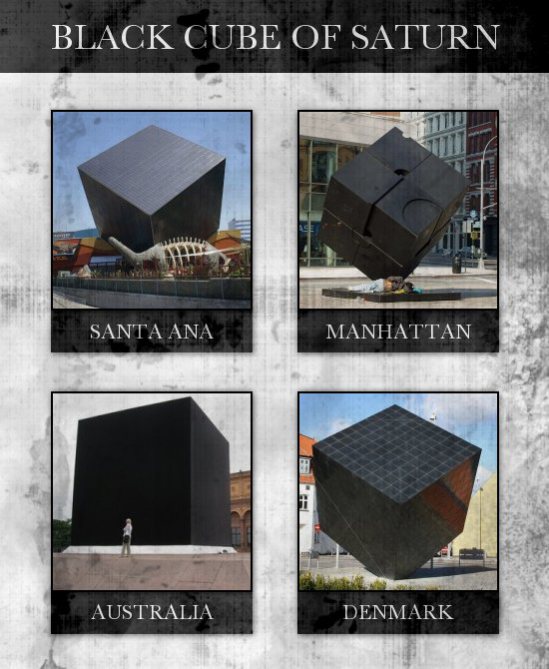




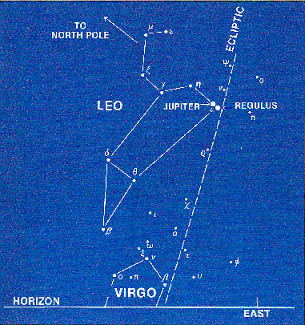
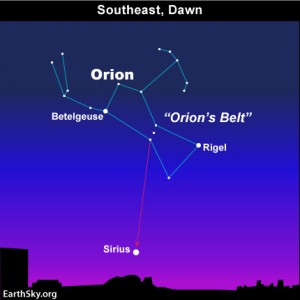



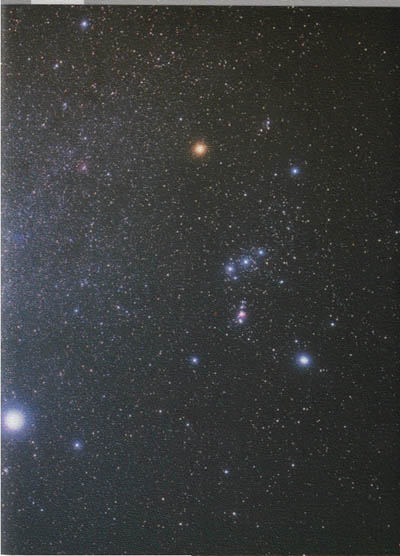

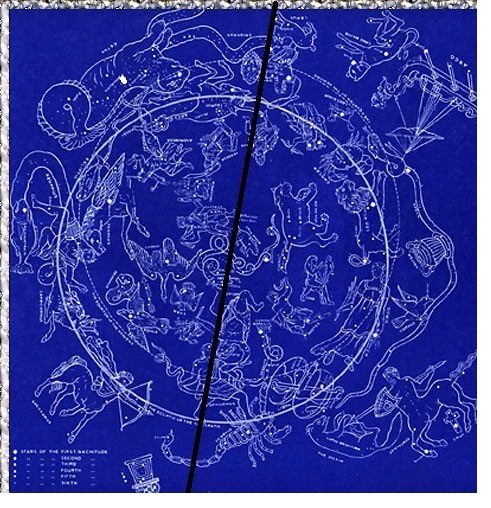
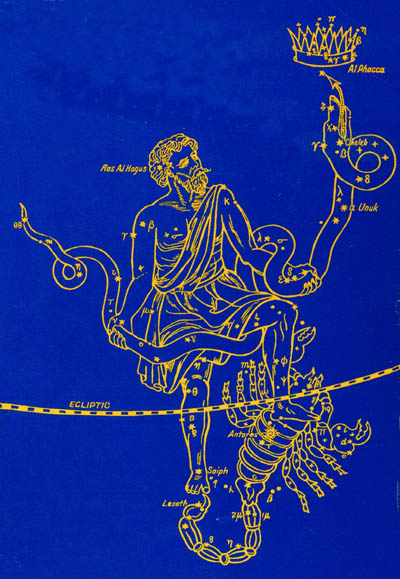
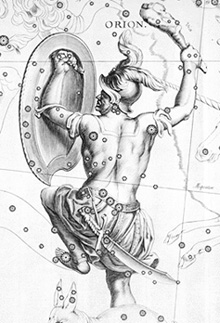
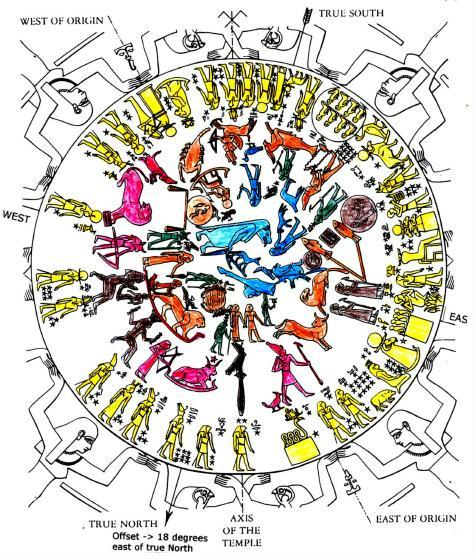
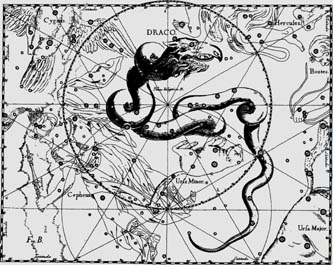
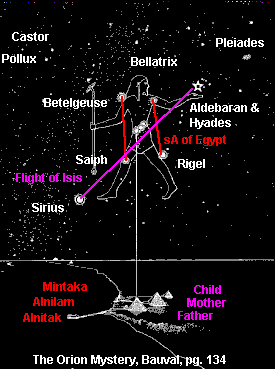

![[AAO Photograph]](https://www.naic.edu/~gibson/pleiades/ukschmidt/pleiades_ukschmidt_clean_names.jpg)

